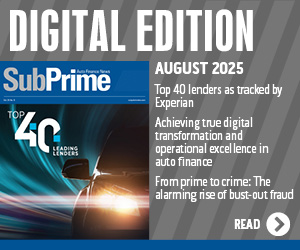Credit Acceptance Q4 origination volume off to soft start

While still making healthy gains in consolidated net income, Credit Acceptance chief executive officer Brett Roberts pointed to data the subprime finance company shared as part of its third-quarter financial statement to explain how competitive the market is to grow its portfolio with contracts that will mature and be profitable.
When looking at Q3 figures, Credit Acceptance generated a 12-percent year-over-year lift in origination volume as the company booked 82,460 contracts through 7,320 active dealers.
But when Roberts gave a glimpse at how the fourth quarter began, he mentioned that Credit Acceptance sustained an 8.3-percent drop-off in originations during October compared to the same month a year earlier.
“I think the primary driver that you see throughout the release is we continue to be in a difficult competitive environment. It’s one that’s been in place for quite some period of time,” Roberts told investment analysts during Credit Acceptance’s quarterly conference call.
“Our strategy in prior cycles like this has been to grow the number of active dealers. It’s pretty hard to grow volume per dealer in the environment that’s as competitive as it is today. And we’ve had some success with that strategy in the past. And I think what we allude to in the release, that that strategy gets more difficult as the number of active dealers grows; it becomes tougher to grow that active dealer base at the same rate,” he continued.
And so we're starting to run into a situation where our existing sales force is signing up as many dealers as they’re capable, but it’s not enough to offset attrition and the impact of the competitive environment on volume per dealer and still leave us with rapid growth. I think that’s where we are today,” Roberts went on to say.
Also to remain competitive, Credit Acceptance continued to extend terms. The company indicated its average contract term in Q3 stretched to 52.6 months, up from 49.8 months a year earlier.
And with the company taking on more risk and watching its collection projections sink below 70 percent, Roberts responded to inquiries about how used-vehicle values are going to impact Credit Acceptance’s performance.
“There’s obviously been a lot written about predictions of what used-vehicle values are going to do in the future, we’re certainly aware of all that,” Roberts said. “We track all the vehicles in our portfolio and the change in the Black Book value every month. Obviously it’s a used vehicle, so it’s a depreciating asset that goes down every month.
“What we’ve seen so far this year is a steeper decline in terms of the depreciation on the vehicles in our portfolio than we have typically seen, probably the steepest declines this year going back to, I think 2008 was the last time we saw depreciation this steep. So that’s certainly impacting the loan performance to date, and it’s something that we’ve included in our forecast,” he continued.
As we talked about last time, the actual amount that we receive at auction from the repossessed vehicles isn’t a huge percentage of our total expected cash flows. So we don’t necessarily have a prediction of what those used vehicle values are going to do in the future. It’s not as important to us as it is to potentially other, more traditional lenders. You could write a loan today, it’s a 50-month loan, trying to predict what used vehicle values are going to be over the next 50 months is obviously very difficult,” Roberts went on to say.
“So instead what we do is we try to build a margin of safety into our business model. As you know that predicting collection rates is very difficult, so we try to set up a situation where even if our collection forecast comes in a little shy of what we expected, the loans would still be very profitable. And that strategy has worked for us very well over time,” he added.
To recap, Credit Acceptance’s consolidated net income came in at $85.9 million, or $4.21 per diluted share, for the quarter that ended on Sept. 30. A year earlier, the company said its consolidated net income totaled $74.0 million, or $3.53 per diluted share.
Through nine months, the company’s consolidated net income stood at $245.2 million, or $12.01 per diluted share, compared to $219.7 million, or $10.49 per diluted share, for the same period in 2015.


